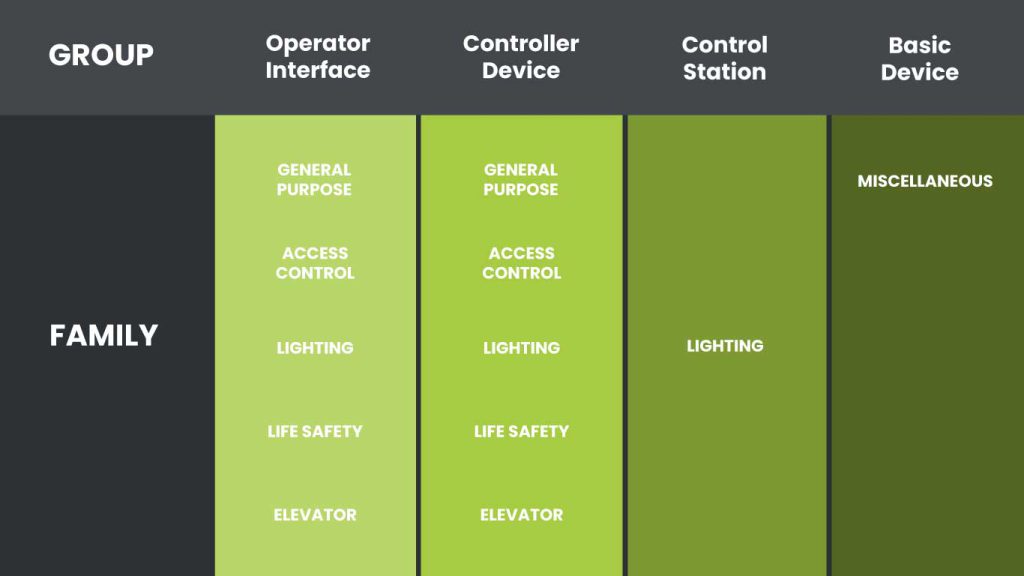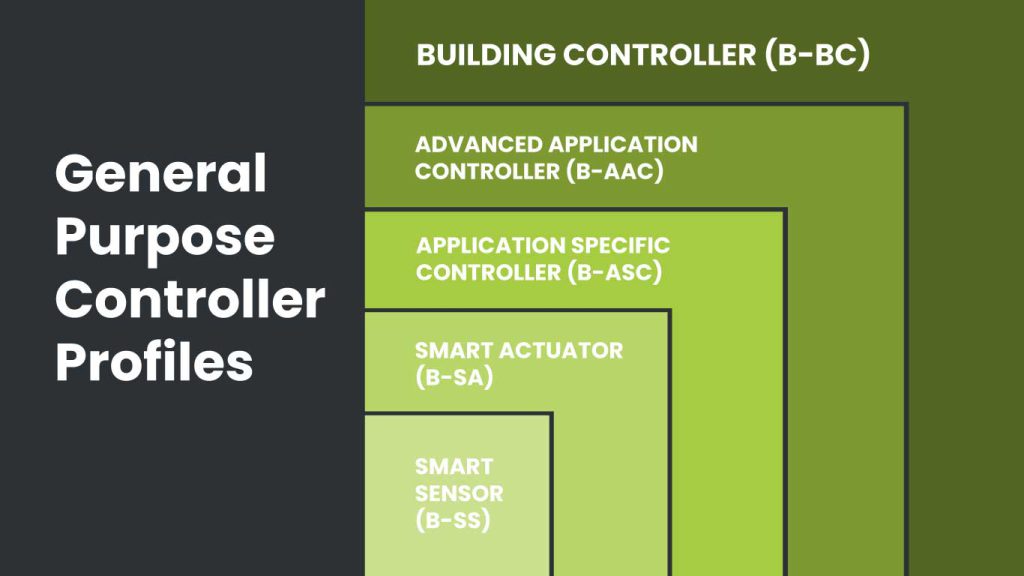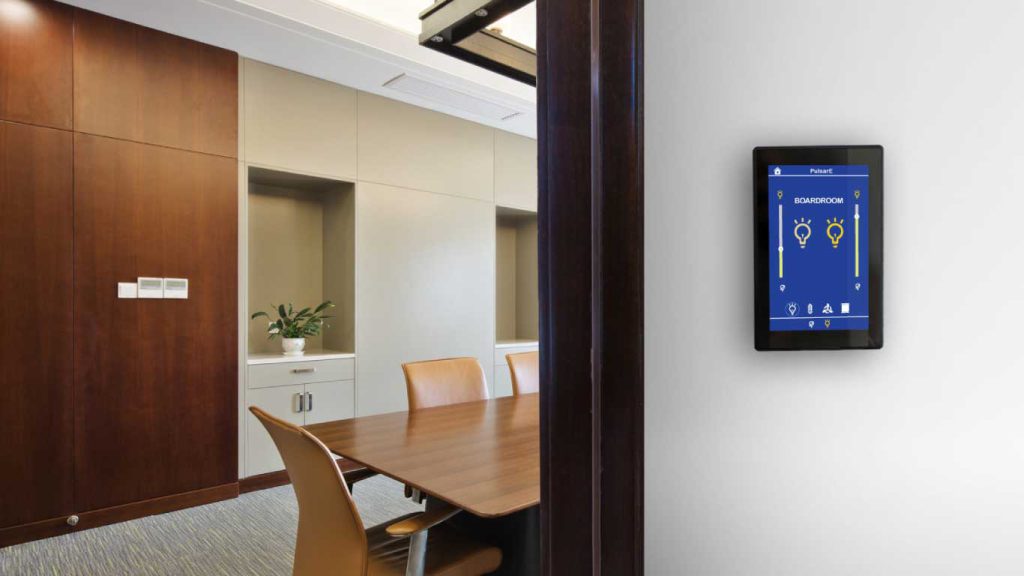In this article in our BACnet Basics Series, we look at Device Profiles, why they’re important and how they’re created. We’ve also included a real world example that illustrates how to use device profiles to accurately specify your own projects.
What are Device Profiles?
As we saw in BACnet Basics: What are BIBBs?, device functions come in five basic categories, each containing specific capabilities. For example, the category Data Sharing (DS) includes capabilities like Read Properties (RP), Write Properties (WP) or Change of Value (COV). If we combined all these services into a minimum collection of capabilities, we would be creating a device profile.
As an analogy, think of the profile “Automobile”. Every machine that claims to be an “automobile” needs the functions of Acceleration (A), Deceleration (D) and Maneuverability (M). Of course, there can be automobiles that do much more, but every “automobile” must, at minimum, perform these three functions (A,D,M).
Definition: BACnet device profiles define the minimum set of BACnet Interoperability Building Blocks (BIBBs) supported by a device claiming that profile. When a device claims a specific profile, you know that it contains a preset of specified functions and services. Profiles are handy because they provide a short-hand method for describing a device and its interoperability capabilities. Device profiles are organized into Groups and Families
Device Groups
Device Groups are general categories of device functions. There are four Group types:
- Operator Interface—Covers the minimum capabilities for workstations and other user interface devices. Devices normally support A-side (Client) functionality.
- Controller Device—Covers anything from programmable building controllers to smart sensors. Devices normally support B-side (Server) functionality, but more advanced supervisory controllers also include A-side (Client) functionality.
- Control Station—Covers lighting control stations that are smaller client devices that support specific user controls such as manual light switches.
- Basic Device—Covers all “miscellaneous” family functionality. Usually included alongside other device profiles.

Device Families
Each Profile Group contains various Families within it. Families cover profiles for various, supported building systems like Lighting, Life Safety, and General Purpose. For example, the Controller Device Group contains profiles for the following Family types:
(Example) Controller Family
- General Purpose—General purpose controllers usually for HVAC and lighting.
- Access Control—Access control controllers such as an access control panel
- Lighting—Lighting controllers such as supervisory lighting controller
- Life Safety—Life safety controllers such as a fire detection panel.
- Elevator—Elevator controllers
Let’s zoom into the General Purpose profile family within the Controller Device Group and see what BIBBs it contains.
- Building Controller (B-BC) —Field programmable and configurable supervisory controllers in HVAC and general purpose application.
- Advanced Application Controller (B-AAC)—Controllers that run advanced HVAC or general purpose control applications.
- Application Specific Controller (B-ASC)—Controllers that run specific HVAC or general purpose control applications.
- Smart Actuator (B-SA)—Small, commendable actuator devices.
- Smart Sensor (B-SS)—Small sensors that provide sensor values to other devices.
BACnet device profile Families are organized in a container hierarchy. As you move up in complexity, you increase the minimum amount of BIBBS required. Like nesting dolls, each profile contains all the minimum profiles from the previous ones.
For example, the above General Purpose BACnet profiles increase in complexity as you move up from Smart Sensor to Building Controller. All BIBBS included in a Smart Sensor profile are always included in a Smart Actuator profile, and all the BIBBs included in those two profiles are always included in an Application Specific Controller, and so on.

Although higher level BACnet profiles contain more BIBBs, it’s not the number of profiles that matters. Each profile requires a minimum number and type of profiles. So, even if a device contains or exceeds the minimum number of BIBBs, it doesn’t guarantee it will meet the standard. It must contain the minimum number of the correct BIBBs to meet the profile standard.
Specifying Device Profiles: Boardroom Example
Let’s use the Device Profile Quick Reference Guide to see an example of how to choose the device profiles for a real-world project. Read the following scenario:
- You want to outfit a medium-sized boardroom equipped with a control panel with a built-in controller. The panel will control the room’s temperature and lighting. You also need manual lighting controls near the door.
To determine the device profiles needed for the project, we can start by listing the functionality we need. We will need HVAC controls for temperature. For lighting, we will need controls for both the panel and a manual user control switch on the wall. Therefore, we will need functionality from the Controller Group and Control Station Group.
Next, we can determine what Families we need within each group.
For the Controller Group, we need:
- General Purpose Family for HVAC
- Lighting Family for panel control lighting
- Access Control Family for access
For the Control Station Group, we need:
- Lighting Family for manual switch lighting control
Finally, we can choose specific profiles to fulfill our HVAC and lighting functionality.

HVAC Profiles
In the Reference Guide, we see the following profiles for the General Purpose Controller Family:
- B-BC: The building controller is intended for field programmable and configurable supervisory controllers in HVAC and general purpose applications.
- B-AAC: The advanced application controller is intended for controllers that run advanced HVAC or general purpose control applications. It does not require being configurable through BACnet.
- B-ASC: The application specific controller is intended for controllers that run specific HVAC or general purpose control applications. It does not require being configurable through BACnet.
- B-SA: The smart actuator is intended for small actuator devices that allow being commanded.
- B-SS: The smart sensor is intended for small sensor devices that provide sensor values to other devices.
We can ignore the last two profiles, because we need neither actuators (B-SA) or sensors (B-SS) for the project. We can also eliminate the Building Controller (B-BC) profile because it does not require supervisory control. Depending on our HVAC needs, we could choose either the Advanced Application (B-AAC) or the Application Specific (B-ASC) profile.
Lighting Profiles
In the Reference Guide, we see the following profiles for the Lighting Controller Family:
- B-LS: The lighting supervisory controller is intended for controllers in lighting applications that can command and operate subordinate lighting controllers, in particular through group write commanding.
- B-LD: The lighting device is intended for lighting controllers that control individual lights or groups of lights. Normally used as leaf nodes in lighting group setups.
We would choose the B-LD profile if the panel only controls one group of lights. However, if the lighting is more complex, we might opt for the B-LS with supervisory controls.
Control Station Profiles
Because the room also requires manual user lighting controls, we need a profile from the Control Station Family. In the Reference Guide, we see the following profiles:
- B-ALCS: The advanced lighting control station is intended for sophisticated control stations that support user view, control and limited configuration of lighting functionality. Provides full commanding support of lighting objects and group operations for them.
- B-LCS: The lighting control station is intended for control stations that support simple control of lighting functionality and limited status indication. Provides limited support of commanding lighting objects.
The simpler B-LCS would work for this project. But, again, depending on the complexity of the room’s lighting, we might choose the more complex profile.
Conclusion
Through the Boardroom Example above, we can see how BACnet profiles make project specifications easier and more accurate. Standards and profiles support an accurate procurement process, requiring less change orders and adjustments. Defining capabilities also creates an outcomes-based workflow so that buildings function the way owners and tenants need them to.

